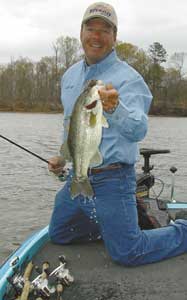
One of the things successful bass fishermen notice is patterns change as the seasons change — but for a number of different reasons.In the spring, you can count on catching bass near rocks — that’s probably the primary cover they’re using.
As the seasons change, bass will be near different kinds of cover as they move to different areas in a reservoir or a river. Stumps will be good at different times, pea gravel or sandy banks will be great during the spawn, artificial cover like boat docks and piers can be No. 1 at other times.
In November, the best cover I can think of fishing is a brush pile. I’ve had a lot of success fishing brush piles late in the fall — to me, they work a lot better at this time of year than any other. It’s the opposite of the early spring when everything is at rocks.
One reason is bass are eating a lot more baitfish and crappie and bluegill and white perch in the fall. And there’s a reason for that, I believe. I’ve noticed, at least at Lake Murray, I see a lot of crawfish in September and October, and they always look to me like they’re digging the holes where they’re going to stay during the winter.
So part of bass getting on brush piles may be crawfish are scarce in November, so the bass move to a different type of cover, the kind where the baitfish and crappie and bluegill and white perch are more likely to be around.
The brush piles I’m concentrating at are generally from the backs of creeks to midway back, and they’re in shallow water. In South Carolina, our falls and winters can really vary. Sometimes, we get our first good hard frost by the end of October, and sometimes, it doesn’t come until the end of November. Either way, you’ve typically got water temperatures down in the 60s, and you’ve got bass at a lot of visible brush piles in 5 feet of water or less.
If we haven’t had a lot of cold weather, there won’t be any reason for the bass to be close to deep water, so they can be t brush piles that are nowhere close to the creek channels or deep water. If we’ve had some cold weather, more likely toward the end of the month, there’s a better chance that you’ll find them t brush piles that are closer to deep water.
I’ll fish brush piles with a variety of baits, depending on where I find the fish and the clarity of the water. If the water is pretty clear, I’ll use a jig or a worm. If it’s a little bit stained, I’ll use a spinnerbait or a crankbait.
The Buckeye “mop” jig I won at Clarks Hill with last spring is a really good bait to fish at brush piles late in the fall. I like a brown jig with a green pumpkin trailer; I’ll use a 3/8-ounce jig when they’re pretty shallow, and a half-ounce jig when they’re a little deeper.
When I’m fishing a crankbait at brush, if the brush is fairly shallow, I like to fish a little shallow-running bait with a square or coffin bill — there are a lot of homemade baits around like that, flat-sided baits, and they really work well because they come through the brush better. If the brush is a little deeper, I’ll use something like a DT-10, and I’ll be using something along the line of a baitfish or bluegill color.
I’ll stick with those colors all the way until after the first of the year, when I go back to crawfish.
I spend a lot of time watching my depth-finder, looking for places where a lot of baitfish are, then looking for brush piles at those areas.
When I find a brush pile I want to fish, I go at it in a certain fashion. I know a lot of people believe your first cast should go in the thickest part, in the middle of the brush where you think the big fish are, but one of the most frustrating things is to be fishing a brush pile and get hung up on your first cast.
I like to try and skirt the perimeter of a brush pile with my cast. I’ll try one cast at one side and a second cast at the other because I want to get a big fish to come out and hit my bait at a place where I’ve got a better chance of getting him in the boat. But I’ll never leave a brush pile without putting a bait right down in the middle of it.
There’s another really good reason to have a lot of brush piles to fish during the fall. I usually carry a couple of crappie rods with me, and if the bass aren’t really biting, I’ll crappie fish at brush piles, and I can catch enough bring home so I can fry ’em up and eat ’em while I’m watching a college football game on the television.
Davy Hite is a 40-year-old native of Saluda who now resides in Ninety Six. He has fished professionally since 1993, when he qualified for his first Bassmasters Classic. He was the BASS Angler of the Year in 1997 and 2002 and has won the 1999 Bassmasters Classic and the 1998 FLW Tour Championship. He is sponsored by Triton boats, Evinrude outboards, All-Star rods, Pfleuger reels, Pure Fishing (Berkeley), Owner hooks and Solar-Bat sunglasses.




Be the first to comment